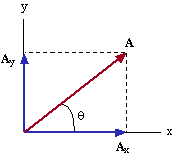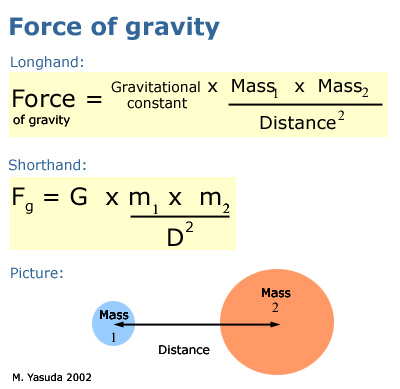Vectors
Vectors are a mathematical creation designed to shorten the notation used in physics and are useful later on for picturing the physical reality of a given mathematical framework.
To begin with we define a 'quantity' to be a measure of a physical property such as mass or height. A 'scalar' quantity is then defined to be a quantity that does not require a direction; for instance mass has no direction, I cannot say that I have a mass of 1kg south and 1kg west- mass has only magnitude. A 'vector' quantity however is a quantity that has both magnitude and direction such as force; a force on me of 1N south is different to a force of 1N north- I will go in different directions!
The direction of a vector quantity may be represented with an arrow and the magnitude of the given vector quantity may be represented by the length of the arrow. If you look at the vector A(written A) below you will see that it is directed East and theta degrees North. A has magnitude A.
Using Pythagoras' Theorem for right-angled triangles, it is clear that A is equal to the square root of (Ax squared + Ay squared).

A 'unit vector' has magnitude 1. A unit vector in the x-direction is labelled i and a unit vector in the y-direction is labelled j. Every vector in the plane may be written in terms of i and j. A in this case is equal to Axi+Ayj. This vector is now written in 'component form'.
For a more comprehensive description of vectors click here
Notation and Units
Notation is of key importance in physics- if you don't understand the
notation you're not going to understand the physics.
For instance when I wish to multiply two quantities together, usually I
would write V*T but for handiness sake in physics we write VT without the
multiplication symbol *. The tiny "proportional to" symbol is over there to the
right.
 It is similar to the greek lower case
letter alpha.
It is similar to the greek lower case
letter alpha.
As for the units used in physics- there are 7 basic units from which every other unit is a derivative. Of those 7, only 5 are used regularly in physics: The SI base unit of length(the metre/m), mass(the kilogram/kg), time(the second/s), temperature(the kelvin/K) and electric current(the ampere/A). The SI is the International System of Units used as a standard by most scientists. All other units such as the Newton=(kg m/s/s) are combinations of the above.
Newton's Laws
Isaac Newton was born on Christmas Day 1642 and came to be the foremost scientist of his day. He was the first to succeed in mathematically pinning down the all-elusive force of gravity. He also developed his 3 laws of motion which formed the bulk of mechanics for the last 400 years. His laws are still used with much success today. They are as follows:
- Law 1Every body remains in a state of rest or of uniform motion in a straight line unless acted upon by an external force.
- Law 2The rate of change of momentum of a body is proportional to the applied force and takes place in the direction in which the force acts.
- Law 3If one body, A, exerts a force on another body, B, then B exerts an equal and opposite force on A.
The first law just asserts that a body will stay doing what it's doing until something happens to it(a force is applied). The second law tells us that when a force is applied then the rate of change of the [momentum=(mV)mass times velocity] is proportional to the applied force giving rise to the formula F=ma where F and a are vectors. Finally the third law is equivalent to the well known statement, 'to every action there is an equal and opposite reaction'.
Gravity
Another great triumph of Mr.Newton was his ideas on gravity. He asserted that gravity, the force that keeps our feet on the ground and the moon in orbit around the earth, was caused by a force exerted on any mass by all other masses. He said the force F=GM1M2/(dsquared) where G was his constant of proportionality, M1 was the first mass, M2 the second mass and d was the distance between the two masses. F and d are vectors, G, M1 and M2 are scalars.

Disclaimer: This webpage was created by Simon Hall- Copyright2004. None of the diagrams or pictures are my own but were used in an attempt to better convey the information within the webpage.
